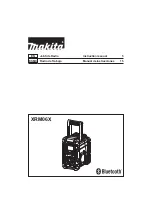
HFp Antenna User’s Guide
The 60 Meter Band
The 80 Meter Coil also allows the HFp to be tuned to the new 60 Meter band. The 60
Meter channelized frequencies are: 5332, 5348, 5358.5, 5373, and 5405 kHz. (Note that,
originally, 5368 KHz was one of the channels, but it was replaced with 5358.5 in Nov,
2011) The last channel is common to the UK amateur experimental band plan. The
following setup chart is also included on the 80 Meter Laminated Card, for easy field use.
Band
El - 1
El - 2
El - 3
El - 4
El - 5
El – 6
El - 7
Whip
60M
1 Stripe
1 Stripe
3 Stripe-
Down
2 Stripe-
Down
1 Stripe
80 M
Coil
1 Stripe
4.5 Sect
The radials should be extended to the 9th mark for the 60M configuration. The top
Pull-Out-Whip should be extended to 4.5 sections for the 60M setup, and adjusted
as needed.
Important Note:
In order to properly use the 60 Meter band, you must set your radio to
upper sideband mode, and set the carrier frequency (the frequency shown on the radio's
display) 1.5 KHz lower than the channel frequency.
Tuning
As usual, the configuration table should be used as a starting point. Remember that it
defines a setup on the ground and in the open, away from nearby objects. You may have
to adjust the mix of elements to get the antenna to perform in your specific location.
Typically, if some nearby object is lowering its resonant frequency, moving one of the
loaded elements up (or, less desirable, removing one of the top elements) will get the
antenna back on target. The whip can be shortened, but on the 80M band, the whip
doesn't provide much adjustment.
Use the tuning procedures described in the HFp Users Guide to check the resonant
frequency of the antenna.
Guy Lines
Guy lines are included with the HFp for use when it is windy, or when the antenna will
be left up for some time. The guy lines should always be used with the 80M vertical
setup. The antenna is not heavy enough to stand up in any but the lightest breeze when it
is configured for 80 meters.
On the lower frequency bands you usually need to take off the top assembly of elements
in order to adjust the whip length to get the lowest SWR at your favorite frequency.
With the new Special IEC which allows the element stack to rotate freely with the Guy
Lines attached, it is easy to just unscrew the stack, make an adjustment, and re-install the
element stack.
This makes whip and element adjustments on the longer setups much less of a hassle.
©2006, The Ventenna Co. LLC
Last Update: Feb, 2019




















